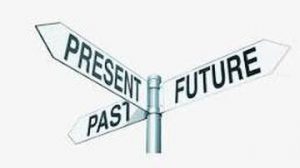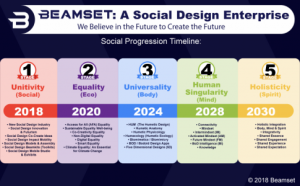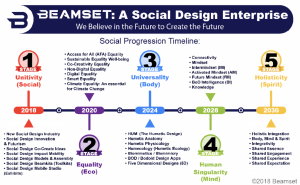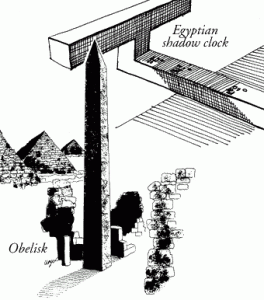The Progression 4 of Beamset Social Design and Time Projection
4D Progression or Progression 4 (Time)
Beamset is set to forge ahead into a new reality of a Social Design world of new ideas, innovations, products, and services and create an opportunity for positive change.
Beamset’s direction is to build bridges between society and critical social problems. In developing unique solutions and connections with social impact and Social Design.

Beamset Time Projection aims to give people a sense of belonging and contributing to the present and future, working towards a common good for society and human well-being.
Overview
I. BEAMSET TIME PROJECTION
- ◼The Beamset Social Design Progression Timeline
- ◼The Beamset Cyclical Timeline of Events
- ◼The Beamset Social Design Generation (SDG)
- ◼The Benefits of Time Projection
II. DESCRIPTIONS OF TIME
- ◼ A Short Description of Time
- ◼ Multiple Descriptions of Time
- ◼ Fourth Dimension or 4D Time
III. PAST AND PRESENT TIME
- ◼ A Short Description of Time
- Sun Clocks or Sun Dials
- Obelisks (Four-Sided Monuments)
- Earliest Annual Calendars
- ◼ Today’s Modern Atomic Clocks
- Atomic Clocks
- National Atomic Time Scale
- Incredible Accuracy for 300 Million Years

I. BEAMSET TIME PROJECTION
◼ The Beamset Social Design Progression Timeline
Thinking about the present and the future allows us to imagine what kind of present existence we want to live in or how we can get there in the future.
The Beamset Social Design Progression Timeline attempts to systematically explore predictions and possibilities for the future, taking known facts and trends from present society and considering how they may evolve down the line.

◼ The Beamset Cyclical Timeline of Events
Beamset’s timeline spans from the beginning of each Social Design Generation (SDG) and its five cyclical stages to either a finite completion, if the end goal is accomplished, or an infinite continuum, if the project is ongoing and more goals emerge

◼ Social Design Generation (SDG)
The Beamset Social Design Generation (SDG) is a recurrent event or process that involves five distinct cyclical stages:
- Stage I: Social
- Stage 2: Eco
- Stage 3. Body
- Stage 4. Mind
- Stage 5. Ethos/Spirit


◼ Benefits of Time Projection
- Offers people a sense of belonging and contributing to the present and future
- Serves the greater good of society and human well-being
- Helps people make informed decisions regarding both the present and future
- Makes thinking about the future more approachable
- Provides meaningful direction in the present, improving psychological well-being
II. DESCRIPTIONS OF TIME
◼ Time Projection
Time Projection refers to an estimate of the amount of time between two moments or events
◼ A Short Description of Time
Time is the progression of events from the past to the present into the future
◼ Multiple Descriptions of Time
Time is a measured or measurable period during which an action, process, or condition exists or continues; Duration. (Merriam-Webster Dictionary)
- Time is an event or occasion. It’s the point or period when something occurs; an appointed moment for something to happen, begin or end; an opportune or suitable moment, such as, time for a change
- Time is the indefinite continued progress of existence and events that occur in apparently irreversible succession from the past, through the present, into the future
- Time is a component quantity of various measurements used to sequence events, compare the duration of events or the intervals between them, and quantify rates of change of quantities in material reality or conscious experience
- Time is often referred to as a fourth dimension, along with three-dimensional space
◼ Fourth Dimension or 4D Time

- Time is often referred to as the fourth dimension, along with the three spatial dimensions: 1D, 2D, and 3D
- One Dimension (1D): In this dimension, an object only moves in one direction. Objects in 1D have one measurable unit: length. An example of a 1D object is a straight line
- Two Dimensions (2D): In this dimension, an object can move in two measurable directions: length and width. A common example of a 2D object is a rectangle
- Three Dimensions (3D): In this dimension, an object can move in three measurable directions: length, width, and height
- Four Dimensions (4D): In the fourth dimension an object is allowed to move in a fourth direction: time. The four-dimensional world is a mathematical extension of the concept of a three-dimensional (3D) world that adds time as a fourth measurement by which to differentiate objects
II. DESCRIPTIONS OF TIME
◼ Short History of Earliest Time

- Sun Clocks or Sun Dials
Time can be rightly termed the oldest phenomenon in human history. Time has been measured for as long as 6000 years, starting in the great civilizations of Egypt and the Middle East, who used clocks based on the position of the sun to divide their days into segments. Today, we divides days into hours, minutes, and seconds.
- Obelisks (Four-Sided Monuments)
Built around 3500 BCE, Obelisks are tall, slender four-sided monuments that worked similarly to sundials. As civilization progressed, Egyptians began to measure time by observing the motion of shadows around obelisks, enabling them to divide the day into morning and afternoon. Later, they made use of additional markers around the monument’s base that indicated further subdivisions of time.
- Earliest Annual Calendars
The Egyptians were the first to realize that a star forms next to the sun every 365 days, knowledge that enabled them to develop the earliest 365-day calendar. It is estimated to have been designed around 3100 BCE (Before the Common Era) which is consequently one of the earliest years recorded in history.
◼ Today’s Modern Atomic Clocks

- Atomic Clocks
Today, there are several means of measuring time, with varying levels of accuracy. Some common examples are watches and clocks, which may run slightly too fast or slow. The most precise timekeeping device is one that is less widely known: atomic clocks. To achieve their precision, these clocks work with the high frequency vibrations of atoms at specific, unchanging energy levels
- National Atomic Time Scale
Atomic clocks are used as primary standards for international time distribution services to control television broadcasts’ wave frequency. They are also used in global navigation satellite systems such as GPS
In many countries, national standards agencies have to maintain a working network of atomic clocks compared and synchronized in real-time. The synchronized atomic clocks define a continuous and stable time scale for several uses.
- Latest Atomic Clock – NIST-F2
In April 2014, the Department of Commerce’s National Institute of Standards and Technology (NIST) in the United States introduced the latest atomic clock, the NIST-F2, which will be used as the U.S. civilian time and frequency standard
- Incredible Accuracy for 300 Million Years
In April 2014, the Department of Commerce’s National Institute of Standards and Technology (NIST) in the United States introduced the The International Bureau of Weights and Measures reported that the NIST-F2 is the world’s most accurate time standard. The new atomic clock will neither gain nor lose one second in about three hundred million years

